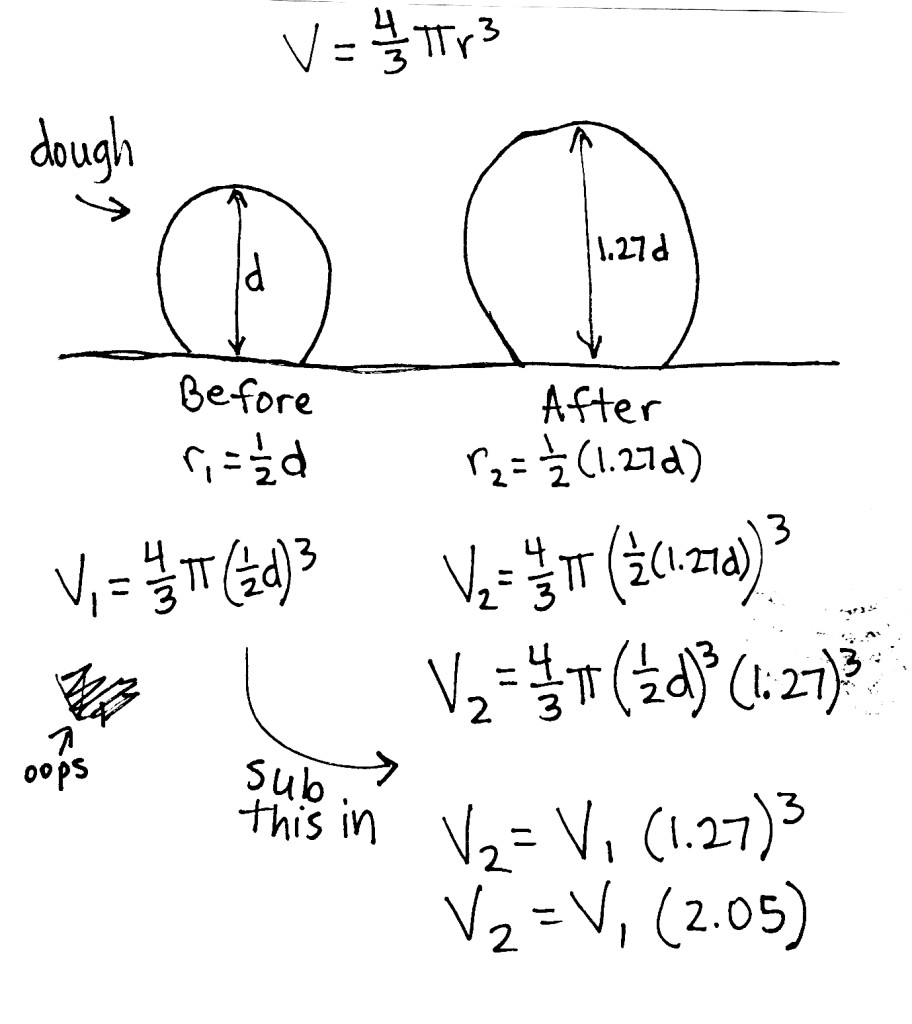What really causes oven spring? That’s what Doc D. wants to find out.
For the non breadies out there, oven spring is the rapid expansion that occurs when bread dough goes into the oven. Doc had read that there are 3 components:
1. The gas that is in bubbles in the dough expands when heated;
2. The CO2 that is dissolved in the dough comes out of solution and enters the bubbles, creating more gas (which expands); and
3. There is a final burst of activity by the yeast that produces more CO2. [1]
Doc contacted me because he wondered how the three components contribute. He’d made a mathematical model of oven spring that used the ideal gas law (PV=nRT) to model the expansion of the gases already present and the solubility of CO2 as a function of temperature to model the gas coming out of solution. His model suggested that the final production of CO2 by yeast would play a very small role.
Doc pondered different ways to estimate this CO2 production. They’re over my head, so I’ll quote him: “by regression from loaf volume vs time rather than from modeling population density, growth rate, sugar availability, etc.” Then he came up with an experiment: he’d make two identical loaves, and before putting them into the oven, one loaf would be hit with a high dose of X-rays to kill the yeast. He acknowledged that such a dose might also affect the dough.
Last month, Doc contacted me with his latest results. He had spoken with some X-ray experts (both radiation biologists and people who sterilize medical equipment with X-rays):
“The biologists explained that yeast is pretty tough and will still metabolize glucose and produce CO2 after they have received a (high) lethal dose of ionizing radiation. They don’t actually die until they divide as that is when the chromosomal damage induced by the radiation interferes with cellular processes (there are also incredibly robust DNA repair processes that work fast and extremely well). The end result is that in order to inactivate the yeast, you have to give it an enormous dose of X-rays, such a high dose that it would either take forever to kill the yeast or (if you deliver the dose over a short period) heat up the dough well beyond where you could claim that you hadn’t baked it in the process. So that avenue to testing just doesn’t pan out.”
Doc realized, however, that he could easily “view” the existing gas in the dough by placing a proofed dough ball into a bell jar and quickly creating a vacuum. This would at least show him if the available gas was enough to expand the dough fully.
The dough in the vacuum expanded as much if not more than his dough usually does during baking. He writes, “So it is easily shown that there is enough CO2 in proofed dough to yield the observed oven spring without any “final burst of CO2” from the dying yeast. The remaining issue is whether there is a mechanism (heat, pressure, volume expansion, dough relaxation and extension limited by dough strength) that can really expand the available gas by the required amount. Oh yes – there is the CO2 dissolved in the dough that is not included in this little experiment.”
Here are Doc’s photos of the dough before the expansion and after, about 30 seconds later:
He measured the change in height as a factor of ~1.27; using the equation for the volume of a sphere, this corresponds to a volume increase of about 2. I had to write out the equations, so here they are:
Doc still wants to know how this expansion relates to a normal oven. (I’m personally thinking we should all switch to “vacuum ovens.”) Do you have any ideas for further tests? Post them in the comments!
[1] Buehler, Emily. Bread Science: the Chemistry and Craft of Making Bread. Carrboro, North Carolina: Two Blue Books, 2006, p186. The original sources were [2] and [3].
[2] Moore, Wayne R. and R.C. Hoseney. “The Leavening of Bread Dough.” Cereal Foods World 30 (1985) 791-792. This paper shows that the CO2 present is not enough to explain oven spring, and that ethanol and water vapor must therefore be involved. I just sent it to Doc, and he’s got some ideas about it; I now need to look up the references.
[3] Burhans, Merton E. and John Clapp. “A Microscopic Study of Bread and Dough.” Cereal Chemistry 19 (1942) 196-216. See page 214.





The bell jar pictures are fantastic. I wonder how much a role the oven temperature has to do with oven spring.
Hi Josh, Remember that in the oven (unless it is my fantasy vacuum oven!) there is not a vacuum that allows the dough to expand. So, it is the heat that affects the dough (expanding the gases inside and such) and enables it to push outward.